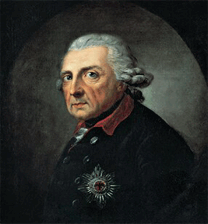History-
Compared to other European cities, Berlin with its less than 800 years is considered a rather young city, but its history is unique. The two founding towns Cölln and Berlin affiliated in 1307 for a union. After riots, elector Friedrich II. declared the twin town his residence in 1451.
1701, after elector Friedrich III had coronated himself as king Friedrich I in Prussia, Berlin rose to a Royal Capital and Residence Town . Numerous well-known buildings were designed then, his grandson Friedrich II (1740–1786) continued with the architectural redesign of the city, assisted by the famous architect Knobelsdorff . 1806–08 Napoleon's troups occupied the city; after the victory of Leipzig the Quadriga, which was annexed by Napoleon , was returned to the Brandenburg Gate in 1814.

Frederick the Great.
In the following decades, the splendid classicist buildings by Schinkel and the blossoming park areas by Lenné emerged. Since the middle of the century, Berlin's economy boomed, the population grew rapidly. After 1871, when the city had become capital of the 'Deutsches Reich' , the construction and economy boom even grew in the Gründerzeit ("founding era"), Berlin's population exceeded one million. The heavy defeat of World War I as well as revolutionary riots caused a deep crisis of the Reich and its capital. Out of the riots the Republic was proclaimed in 1918 . Despite the difficult economical situation and further riots, art and culture flourished during the twenties; innovative theatre productions, splendid film premieres, vivid vaudevilles and an uncomparable nightlife made Berlin the centre of the "Golden Twenties" . Hitler's takeover in 1933 marked the beginning of the persecution of Jews, Communists, Homosexuals, Oppositionals and many more.

In this Soviet photograph from May 2 1945, Red Army soldiers are raising the Soviet flag on the roof of the Reichstag.
After the Nazi terror and the end of World War II the city was finally devastated in 1945 . The four allies divided Berlin in four parts: the East was administered by the Soviet Union, the Southwest by the USA, the West by Great Britain and the Northwest by France. With the "Berlin-Blockade" in 1948, the city became object of the Soviet-American conflict; Americans and British supplied the three West sectors via "Luftbrucke" with "Candy Bombers". In East and West Berlin the reconstruction began. The construction of the Berlin Wall on Aug 13, 1961 set the seal on the city's division and separated its people.
The city celebrated on Nov 9, 1989 when the Berlin Wall was torn down. After the reunification in 1990 Berlin became residence of the Federal Government, which held its first plenary session in the redesigned Reichstag on Apr 19, 1999. The Reichstag with its new glass dome became an attraction for both Berliners and tourists from all over the world. The new millennium was celebrated with a magnificent party at the Brandenburger Tor. A lot has changed in Berlin since then. And Berlin will keep changing.
